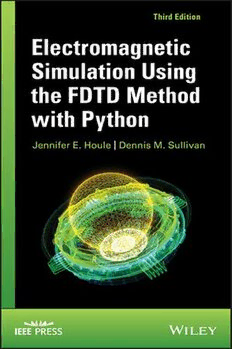
Electromagnetic Simulation Using the FDTD Method with Python PDF
Preview Electromagnetic Simulation Using the FDTD Method with Python
ELECTROMAGNETIC SIMULATION USING THE FDTD METHOD WITH PYTHON IEEEPress 445HoesLane Piscataway,NJ08854 IEEEPressEditorialBoard EkramHossain,EditorinChief DavidAlanGrier AndreasMolisch DiomidisSpinellis DonaldHeirman SaeidNahavandi SarahSpurgeon ElyaB.Joffe RayPerez AhmetMuratTekalp XiaoouLi JeffreyReed ELECTROMAGNETIC SIMULATION USING THE FDTD METHOD WITH PYTHON Third Edition JENNIFER E. HOULE DENNIS M. SULLIVAN Copyright©2020byTheInstituteofElectricalandElectronicsEngineers,Inc.Allrightsreserved. PublishedbyJohnWiley&Sons,Inc.,Hoboken,NewJersey. PublishedsimultaneouslyinCanada. Nopartofthispublicationmaybereproduced,storedinaretrievalsystem,ortransmittedin anyformorbyanymeans,electronic,mechanical,photocopying,recording,scanning,or otherwise,exceptaspermittedunderSection107or108ofthe1976UnitedStatesCopyrightAct, withouteitherthepriorwrittenpermissionofthePublisher,orauthorizationthroughpayment oftheappropriateper-copyfeetotheCopyrightClearanceCenter,Inc.,222RosewoodDrive, Danvers,MA01923,(978)750-8400,fax(978)750-4470,oronthewebatwww.copyright.com. RequeststothePublisherforpermissionshouldbeaddressedtothePermissionsDepartment, JohnWiley&Sons,Inc.,111RiverStreet,Hoboken,NJ07030,(201)748-6011,fax(201)748-6008, oronlineathttp://www.wiley.com/go/permissions. LimitofLiability/DisclaimerofWarranty:Whilethepublisherandauthorhaveusedtheirbest effortsinpreparingthisbook,theymakenorepresentationsorwarrantieswithrespecttothe accuracyorcompletenessofthecontentsofthisbookandspecificallydisclaimanyimplied warrantiesofmerchantabilityorfitnessforaparticularpurpose.Nowarrantymaybecreatedor extendedbysalesrepresentativesorwrittensalesmaterials.Theadviceandstrategiescontained hereinmaynotbesuitableforyoursituation.Youshouldconsultwithaprofessionalwhere appropriate.Neitherthepublishernorauthorshallbeliableforanylossofprofitoranyother commercialdamages,includingbutnotlimitedtospecial,incidental,consequential,orother damages. Forgeneralinformationonourotherproductsandservicesorfortechnicalsupport,pleasecontact ourCustomerCareDepartmentwithintheUnitedStatesat(800)762-2974,outsidetheUnited Statesat(317)572-3993orfax(317)572-4002. Wileyalsopublishesitsbooksinavarietyofelectronicformats.Somecontentthatappearsinprint maynotbeavailableinelectronicformats.FormoreinformationaboutWileyproducts,visitour websiteatwww.wiley.com. LibraryofCongressCataloging-in-PublicationData: hardback:9781119565802 Setin10/12ptTimesNewRomanbySPiGlobal,Pondicherry,India PrintedintheUnitedStatesofAmerica. 10 9 8 7 6 5 4 3 2 1 To Bijan —Jennifer E. Houle CONTENTS About the Authors ix Preface xi Guide to the Book xiii 1 One-Dimensional Simulation with the FDTD Method 1 1.1 One-Dimensional Free-Space Simulation, 1 1.2 Stability and the FDTD Method, 5 1.3 The Absorbing Boundary Condition in One Dimension, 6 1.4 Propagation in a Dielectric Medium, 7 1.5 Simulating Different Sources, 9 1.6 Determining Cell Size, 10 1.7 Propagation in a Lossy Dielectric Medium, 11 1.A Appendix, 14 References, 15 2 More on One-Dimensional Simulation 25 2.1 Reformulation Using the Flux Density, 25 2.2 Calculating the Frequency Domain Output, 28 2.3 Frequency-Dependent Media, 31 2.3.1 Auxiliary Differential Equation Method, 35 2.4 Formulation Using Z Transforms, 37 2.4.1 Simulation of Unmagnetized Plasma, 38 vii viii CONTENTS 2.5 Formulating a Lorentz Medium, 41 2.5.1 Simulation of Human Muscle Tissue, 45 References, 47 3 Two-Dimensional Simulation 59 3.1 FDTD in Two Dimensions, 59 3.2 The Perfectly Matched Layer (PML), 62 3.3 Total/Scattered Field Formulation, 72 3.3.1 A Plane Wave Impinging on a Dielectric Cylinder, 74 3.3.2 Fourier Analysis, 76 References, 78 4 Three-Dimensional Simulation 99 4.1 Free-Space Simulation, 99 4.2 The PML in Three Dimensions, 103 4.3 Total/Scattered Field Formulation in Three Dimensions, 105 4.3.1 A Plane Wave Impinging on a Dielectric Sphere, 107 References, 111 5 Advanced Python Features 129 5.1 Classes, 129 5.1.1 Named Tuples, 131 5.2 Program Structure, 133 5.2.1 Code Repetition, 133 5.2.2 Overall Structure, 135 5.3 Interactive Widgets, 136 6 Deep Regional Hyperthermia Treatment Planning 159 6.1 Introduction, 160 6.2 FDTD Simulation of the Sigma 60, 161 6.2.1 Simulation of the Applicator, 161 6.2.2 Simulation of the Patient Model, 163 6.3 Simulation Procedure, 165 6.4 Discussion, 168 References, 170 Appendix A The Z Transform 171 Appendix B Analytic Solution to Calculating the Electric Field 183 Index 195 ABOUT THE AUTHORS Jennifer E. Houle received the B.S. degree in electrical engineering from the University of Idaho in 2005. Between 2005 and 2012, she was an engineer in thesemiconductorindustry.In2016,shereceivedtheM.S.degreeinelectrical engineeringfromtheUniversityofIdahoandhassincebeenactiveinquantum and electromagnetic simulation. She is presently the Vice President for Research at Moscow-Berlin Simulations. Dennis M. Sullivan is a professor of Electrical and Computer Engineering at theUniversityofIdaho.Hehasdoneextensiveworkinthefieldsofelectromag- netic and quantum simulation including EM dosimetry, hyperthermia cancer therapy,nonlinearoptics,andquantumsemiconductors.In1997,Dr.Sullivan receivedtheawardforthe“BestPaperbyaYoungInvestigator”fromtheIEEE AntennasandPropagationSociety.In2013,hewasmadeafellowofIEEE.He is also the author of Quantum Mechanics for Electrical Engineers and Signals and Systems for Electrical Engineers I. ix PREFACE Thepurposeofthethirdeditionofthisbookremainsthesameasthatofthefirst twoeditions:toenablethereadertolearntheuseofthefinite-differencetime- domain(FDTD)methodinamanageableamountoftime.Forthisreason,the firstfourchaptersarefundamentallythesameaspreviouseditions.Themajor differenceisthecodehasnowbeenwritten inPythonandeachprogramcon- tainsthecodeforgraphicaloutputs.Thegoalofthesefourchaptersistotake thereaderthroughone-,two-,andthree-dimensionalFDTDsimulationand,at thesametime,presentthetechniquesfordealingwithmorecomplicatedmedia. Inaddition,somebasicapplicationsofsignalprocessingtheoryareexplained to enhance the effectiveness of FDTD simulation. Chapter 5 addresses some of the advantages of Python and presents some programming topics the reader may not be familiar with. Some general pro- gramming strategies and best practices are discussed, and these practices are appliedtoanFDTDprogram.Finally,anintroductiontointeractivewidgets ispresented.Thisisaveryusefulfeaturethatcanhelpmakeprogramsthatare user-friendlytothosewithoutprogrammingknowledge.Thischapterisgeared toward those who know a limited amount about Python. Chapter 6containsanexample ofamorecomplicated engineering project: simulating hyperthermia treatment. This is based on research done by the xi
